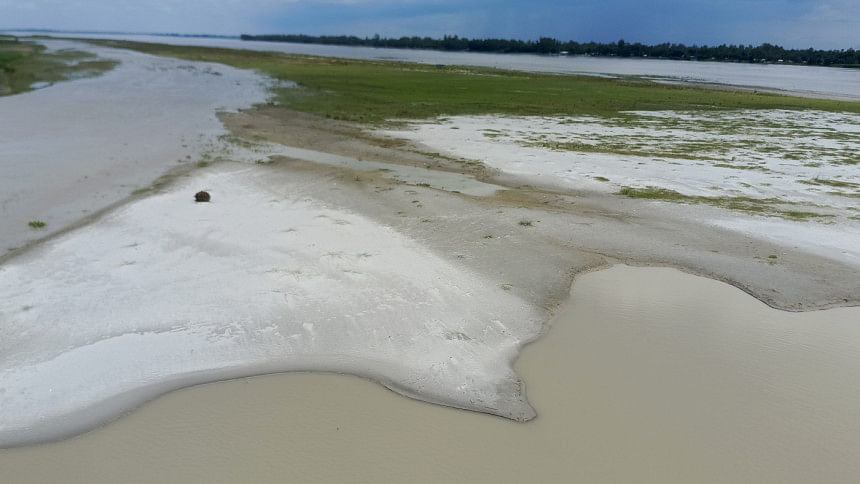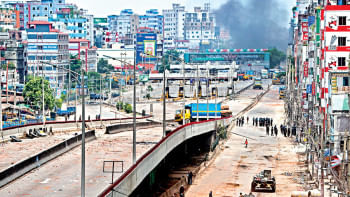Teesta chars remain dry despite peak monsoon

It is monsoon season in Bangladesh, but the Teesta River paints an unusually dry picture. Instead of swelling channels and submerged sandbars, vast stretches of the riverbed remain exposed, a rare and worrying sight for locals who have lived along its banks for decades.
Known for its fierce current during monsoon, the Teesta flows through five districts -- Lalmonirhat, Nilphamari, Rangpur, Kurigram, and Gaibandha.
"I've never seen the Teesta like this in the heart of the monsoon," said 70-year-old Sekendar Ali, a farmer from Rangpur's Mahipur. "This time of year, the river used to flood and submerge all the sandbars, bringing along nutrient-rich silt that blessed our farmlands. Now, the water is scarce."
Farmer Jahir Uddin, 65, shared similar concerns.
Farmers in Lalmonirhat, Nilphamari, Gaibandha, and Kurigram are also reporting similar conditions. In the Kalmati area of Lalmonirhat Sadar, Kader Ali, 60, said his 20 bighas of land on a Teesta char remain dry. "Normally, these lands get submerged every monsoon and become fertile after the water recedes. But this year, the flood never came. Without water and silt, cultivation in winter will be difficult," he said.
Touhidul Islam, sub-assistant engineer and water record keeper at the Teesta barrage, said from June 15 to July 12 this year, the average daily water flow recorded at the barrage ranged between 55,000 and 60,000 cusecs. During the same period last year, the recorded flow ranged from 90,000 to 120,000 cusecs.
Subal Chandra Roy, in charge of the Agricultural Weather Observation Centre in Rajarhat, said less rainfall is a major reason for the situation.
Around 354 millimetres of rainfall were recorded in June this year, compared to 750 millimetres in June last year. Up to July 12 last year, 650 millimetres of rainfall were recorded, whereas this year it is only 27 millimetres.
According to the Water Development Board, around two crore tonnes of silt and sand enter Bangladesh each year through the Teesta from upstream India. Over 100 chars have formed along 115 kilometres of the river within Bangladesh. In the dry season, these sandy lands become cultivable with the help of deposited silt, but as the river's water-holding capacity declines, the sandbars no longer submerge even with moderate flows.
Abdullah Al Mamun, deputy director of the Department of Agricultural Extension in Kurigram, said, "The char lands of the Teesta usually get submerged during monsoon, allowing silt to deposit. This makes them highly fertile in the dry season. But this year, the sandbars haven't been submerged -- it's alarming."
Dalia Water Development Board Executive Engineer Amitabh Chowdhury said it is essential to dredge the Teesta. "This matter has been forwarded to higher authorities," he added.

 For all latest news, follow The Daily Star's Google News channel.
For all latest news, follow The Daily Star's Google News channel. 



Comments